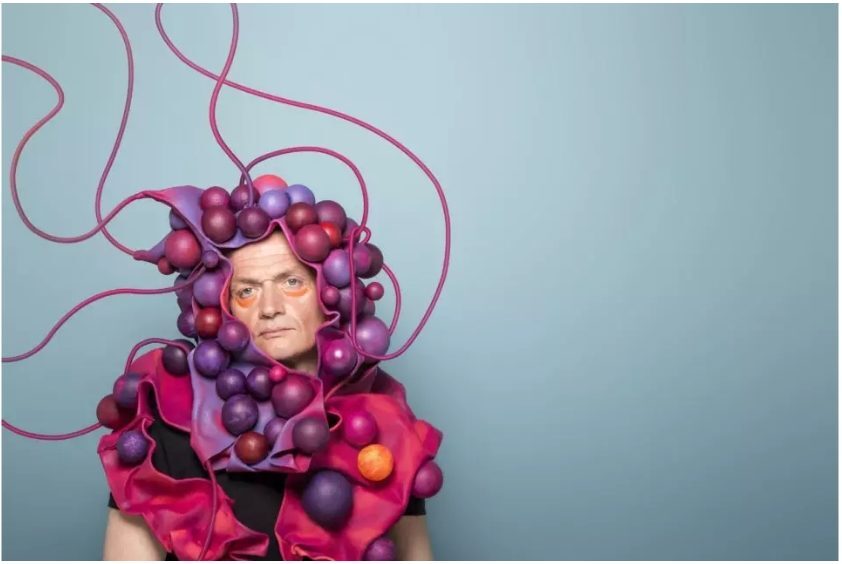This excerpt is taken from the concluding chapter of Performance, Medicine and the Human, a book on contemporary medical performance. The author examines one example of medical performance – A Pacifist’s Guide to the War on Cancer by Bryony Kimmings, Tom Parkinson and Brian Lobel – which playfully subverts the ‘cathartic logic’ of Aristotlean dramaturgy.
A Pacifist’s Guide to the War on Cancer, National Theatre London, 2 November 2016.
By Alex Mermikides
Towards the end of this exuberant musical about cancer, we hear a series of voiceovers, recordings of four ‘real people with cancer’ upon whom some of the show’s characters are based. As each of the recordings plays through, the relevant performer strips off their costume and leaves the stage. Finally, the lead character, Emma, is left alone.
Or rather, this is now the ‘Actor playing Emma’. In a conversation with the director (Bryony Kimmings), also speaking in voiceover, the Actor (Amanda Hardigue) learns that Emma (the character) is based on Bryony. Bryony tells us about her baby son, Frank, recovering now from a severe illness[1]. The Actor tells us about the loss of her father, Steve. And this initiates a ritual in which the company members, now called back to the stage, say the names of loved ones affected by or lost to cancer.
Bryony (voiceover):
And perhaps people in the audience would say the names of people they would like to mention at this point?
The Actor playing Emma ‘holds the space’. The other eleven actors look out into the audience as the houselights come up gently. It’s uncomfortable now. Those on stage wait. Finally, someone says a name. After a while, there’s another name. And then more. I think of the pattering of rain drops. I don’t speak, but there are names in my head. Three generations of men – brother Milton; father Michael; grandfather, another Milton…
And, later, an audience member is invited on stage. This, Bryony’s voiceover tells us, is one of the cancer patients who participated in the creative process. She relates her diagnosis, reads out a list of hopes, and then, on Bryony’s invitation, leads the company, and the audience, in a song.
In this moment of Pacifist’s Guide there is a drive towards a revelation of trauma, a fetishization of suffering and especially of ‘real’ suffering, ultimately our own. This accords with the cathartic paradigm, except that the division between stage and auditorium, character and audience, is rendered more porous than might otherwise be the case. The commonality of experience literally crosses stage, auditorium and the world beyond. As with the Aristolean model, the sharing of experience is founded upon a revelation of suffering, a sort of striptease (in this case literal as well as metaphorical) but it is one that moves us out of the closed fictive space enacted upon the boards. As the performers disrobe, we parse layers of subjecthood, both fictional and ‘real’, present and absent, embodied and disembodied: the characters, the actors playing those characters and the director, the ‘real people with cancer’ in voiceover and then in person, and those other ‘real people with cancer’ who are not bodily present, including those who have passed. There is a ‘creative boundary-crossing’[2]in this that ushers in ‘real’ worlds – that of the theatrical backstage (the director, participants in the creative process) and that of audience member’s personal lives beyond the theatre. This more mutual sharing of experience extends beyond that moment of performance. A companion website to the production includes ‘behind the scenes’ documentaries of the show’s development, videos of experts and patients, and further resources. More unusually, an exhibition, entitled The Institute for Cancer Understanding accompanies the production, along with public talks and ‘drop-in’ sessions on this theme. These offer ‘an interactive space’ in the foyer space of the National’s Dorfman theatre: further displays of materials, resources and videos and, with these, opportunities for interaction:
A pre-show encounter at the Institute of Cancer Understanding, National Theatre London, 2 November 2016
The clever-looking lady explains her stumble into me as we stand alongside each other at a video screen. ‘I’m sorry,’ she says, ‘I’m blind on that side’. And after the video, she tells me about a stroke that has also left her with ‘coordination problems.’ She’s chipper as we take the conversation to the foyer café, but when we sit down she tells me about an initial misdiagnosis – ‘If they had realised it was a stroke sooner, they could have saved my sight’. The table’s other occupants, a pair of medical students, pick up her note of bitterness and join the conversation. The lady recounts her symptoms, she seems pleased to offer them an impromptu opportunity to test their diagnostic skills.
The program for A Pacifist’s Guide, designed to look like a file of medical notes, contains excerpts from an email exchange between Kimmings and producer Judith Dimant (whose experiences of breast cancer inspired the production). These document the early development of the show. In one of these emails, Dimant refers in passing to the diverse groups of people constellating around the project as ‘you/we / all of us together’ and this phrase nicely encapsulates the way the production brings together and blurs the distinction between disciplinary and personal subjectivities. In involving people with cancer in the making process, in turning the theatre foyer into a space for interaction, in inviting us to join in a ritual of naming and singing, the performance exemplifies what Lavender calls ‘a turn in contemporary performance from scenic presentation to evental experience’[3]. This reminds us that theatre is not only a ‘looking place’, but a social one, with the capacity to engender exchange, conversation and ‘creative boundary-crossing’ between and among makers and audiences.
Publishing Site: https://www.bloomsbury.com/uk/performance-medicine-and-the-human-9781350022171/
[1]Kimmings explores her experiences of looking after her sick son more extensively in her subsequent solo performance, I’m a Phoenix, Bitch (2019). A Pacifist’s Guide was later reworked into a new version, which toured in 2018, that did not contain the scene described in this chapter
[2]Whitehead, A. and A. Woods (eds) (2016), The Edinburgh Companion to the Critical Medical Humanities, Edinburgh: Edinburgh University Press.
[3]Lavender, A. (2016), Performance in the Twenty-First Century: Theatres of Engagement, London and New York: Routledge.
This post was written by the author in their personal capacity.The opinions expressed in this article are the author’s own and do not reflect the view of The Theatre Times, their staff or collaborators.
This post was written by Alex Mermikides.
The views expressed here belong to the author and do not necessarily reflect our views and opinions.


















